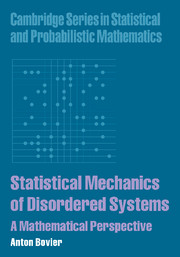Book contents
- Frontmatter
- Contents
- Preface
- Nomenclature
- Part I Statistical mechanics
- Part II Disordered systems: lattice models
- Part III Disordered system: mean-field models
- 8 Disordered mean-field models
- 9 The random energy model
- 10 Derrida's generalized random energy models
- 11 The SK models and the Parisi solution
- 12 Hopfield models
- 13 The number partitioning problem
- References
- Index
11 - The SK models and the Parisi solution
Published online by Cambridge University Press: 25 January 2010
- Frontmatter
- Contents
- Preface
- Nomenclature
- Part I Statistical mechanics
- Part II Disordered systems: lattice models
- Part III Disordered system: mean-field models
- 8 Disordered mean-field models
- 9 The random energy model
- 10 Derrida's generalized random energy models
- 11 The SK models and the Parisi solution
- 12 Hopfield models
- 13 The number partitioning problem
- References
- Index
Summary
Deviner avant de démontrer! Ai-je besoin de rappeler que c'est ainsi que se sont faites toutes les découvertes importantes?
Henri Poincaré. La valeur de la science.We now return to the class of Gaussian mean-field models whose covariance is a function of the Hamming distance, respectively the overlap RN. They were the original mean-field models for spin-glasses, introduced by D. Sherrington and S. Kirkpatrick in, and are considered to be the most natural, or physically relevant ones. Certainly, a large part of the excitement and interest, both in physics and in mathematics, has come from the fact that Parisi suggested a very complex solution, more precisely a formula for the free energy of these models, that has in many respects been seen as rather mysterious and unexpected. Moreover, this formula for the free energy suggested a structure of the Gibbs measures, which is to some extent similar to what we have encountered already in the CREMs. Much of the mystery of Parisis solution certainly resulted from the original method of its derivation, which involved objects such as zero-dimensional matrices, and that appeared to transcend the realm of standard mathematics.
Fortunately, these mysteries have been greatly clarified, mainly due to an ingenious discovery of F. Guerra in 2002, and subsequent work by Aizenman, Sims, and Starr, and M. Talagrand, that allows a clear and mathematically rigorous formulation of the Parisi solution.
The existence of the free energy
A key observation that has led to the recent breakthroughs in spin-glass theory, made by F.Guerra and F.-L. Toninelli, was that Lemma 10.2.1, or rather the interpolation idea used in its proof, is a powerful tool in this context.
- Type
- Chapter
- Information
- Statistical Mechanics of Disordered SystemsA Mathematical Perspective, pp. 218 - 246Publisher: Cambridge University PressPrint publication year: 2006



